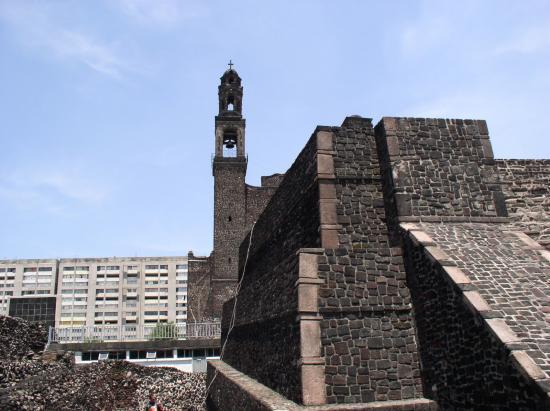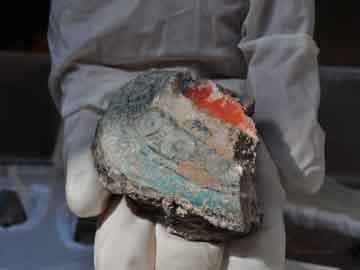Découverte d'un escalier datant de la fondation de Tlatelolco
Source -http://mexiqueancien.blogspot.com/2011/06/decouverte-dun-escalier-datant-de-la.html
A défaut de pouvoir arriver si loin au Templo Mayor de Tenochtitlan à cause de son emplacement, on se pourra toujours se rabattre sur les travaux qui continuent d'avoir. Là, il n'y a pas de pression de la part d'architectes et de bureaucrates en tout genre. Salvador Guilliem avait déjà considérablement déchiffré le terrain des recherches sur la ville-soeur de Tenochtitlan qu'était Tlatelolco. Depuis 1992, on connaît l'existence de deux étapes antérieures du Grand Temple de Tlatelolco sous ce que le touriste peut actuellement voir (phase 1a). En 2007, une deuxième phase de construction a pu être mise au jour sous la forme d'un escalier (phase 1b) : nous vous l'avions présentée dans cette note l'année dernière. Mais les archéologues ont voulu aller plus loin.
En 2009, un puits a été percé depuis la plateforme de la pyramide jusqu'à 7 mètres de profondeur. Là l'équipe de Lucia Sanchez a retrouvé les restes d'une plateforme stuquée sur laquelle reposaient des fragments d'encensoirs polychromes, et une petite colonne avec des restes de peinture rouge, bleue, et noire.

Pyramide double de Tlatelolco, Mexico. Culture Mexica, Postclassique.
Les fouilles ont continué et ont permis entre février et aujourd'hui la localisation de nouveaux éléments architecturaux. Un tunnel transversal avait été percé dans la façade ouest de la pyramide, atteignant 12 mètres de long. Les chercheurs ont dégagé l'escalier qui montait vers un petit temple et une autre partie de la plateforme susmentionnée. Cet ensemble appartient à la phase 1c de la pyramide, datée entre 900 et 1200 de notre ère, soit le Postclassique ancien pour la chronologie de la région et confirmant les hypothèses proposées par Salvador Guilliem l'année dernière. Ils ont trouvé différents objets en céramique et des petites lames en obsidienne, des pierres travaillées pour la construction et le remplissage, ainsi que des os de petits rongeurs.
Cette datation pose problème puisque les témoignages recueillis par le frère Diego Durán expliquent que Tlatelolco fut fondée vers 1337. Donc la fondation de la cité serait plus ancienne qu'on ne le pensait. Reste un problème pour les archéologues du Proyecto Tlatelolco : déterminer si les trois phases retrouvées sont véritablement des phases de construction distinctes ou si elles sont simplement des phases d'agrandissement d'un même édifice, comme on peut le voir à Tenochtitlan.
Toutes ces informations ont été publiés sur le site de l'INAH.

CIV 101 - 201 : Civilisations précolombiennes mésoaméricaines / Mesoamerican Civilizations
REL 201 : Divinités précolombiennes mésoaméricaines / Precolombian religions in Mesoamerica
Mexican Archaeologists Find Ancient Staircase at Tlatelolco, May Confirm First Building
Source - http://www.artdaily.org/index.asp?int_sec=2&int_new=48463

Ceramic fragments, obsidian pieces and small animal bones were found. Photo: DMC INAH/H. Montaño.
When looking for archaeological elements of the first constructive stage of Tlatelolco, to confirm a foundation date, researchers of the National Institute of Anthropology and History (INAH) found at Templo Mayor (Main Temple) a staircase that gave access to a shrine that dates from the earliest architectural stage, as well as a stuccoed floor, probably dated between 900 and 1200 of the Common Era.
The finding may confirm the moment when the first building of Tlatelolco, the twin city of Tenochtitlan, was established, informed archaeologist Lucia Sanchez, director of the archaeological zone.
According to ethno-historical sources such as official chronicles of Fray Diego de Duran and Padre Acosta, the foundation of Tlatelolco took place in 1337, while Tenochtitlan was founded in 1325. Other sources like Historia Tolteca-Chichimeca and Mapa de Sigüenza, report that Tlatelolco was created before or at the same time as Tenochtitlan.
The INAH researcher mentioned that the finding of the staircase adds up to those of the past years. Ceramic fragments, obsidian pieces and small animal bones, part of the pyramid’s filling were found as well.
As the skin of an onion, Templo Mayor of Tlatelolco was studied inside out, taking advantage of a tunnel created in Prehispanic times that goes through the structure.
Lucia Sanchez recalled that between 1992 and 1993, during excavations headed by archaeologist Salvador Guilliem, a complete staircase was found in the occidental façade of the pyramid, at the Stage 1a, as well as remains of another. In 2007, when the work was retaken, a third staircase, also broken, was located in Stage 1b.
In 2009, another exploration from the upper part of the structure took place, which led to finding at 7.5 meters depth, a stucco floor and a small plaster with remains of red, black and blue pigments, as well as fragments of small polychrome braziers.
The archaeologist mentioned that between February and June 2011, 12.5 meters into the tunnel, the staircase that gave access to a shrine was discovered, as well as the continuation of the stuccoed floor located in 2009; the space was named Stage 1c, and could be dated in Post Classic period (950-1200 AD).
The chief of Tlatelolco Archaeological Zone continued mentioning that ceramics, obsidian –mainly small knives-, stone used for construction as well as for filling, and small animal bones were found.
“This material was used for filling; small mollusk shells from the lake were found, indicating this soil was used also for the filling”.
“These elements would correspond to the foundation of the city; according to ethno-historical sources, they would correspond to 1337, but could be older, from 1000 to 1200 of the Common Era”, commented Lucia Sanchez.
The archaeologist said that analysis is being conducted to verify if the 3 stages (1a, 1b and 1c) correspond to different constructive stages or they are just attachments to the temple of Tlatelolco.
She detailed that in order to obtain precise information to complement excavation data, different studies take place on material found in the past, such as ceramics, charcoal and shell, with the collaboration of the INAH Sub Direction of Laboratories and Academic Support and the Paleomagnetism Laboratory at UNAM Institute of Geo Physical Investigations.
“Some analyses will imply Carbon 14, as well as thermoluminescence and archaeomagnetic dating, methods used to determine temporality of ceramic pieces and stuccoed floors”, she explained.
Results will allow, according to Tlatelolco Project objectives, to establish comparisons between Tlatelolco and Tenochtitlan in their earliest stages.
Templo Mayor of Tlatelolco exploration is part of an archaeological project that began in 1987 headed by archaeologist Salvador Guilliem Arroyo with collaboration of researchers Patricia Ledesma, Alejandro Rivera, Claudia Nicolas, Maria de Jesus Alvizar and Lucia Sanchez de Bustamante.